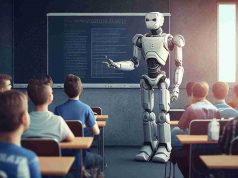The intersection of education and technology is witnessing the emergence of innovative Artificial Intelligence (AI) applications that are fast becoming a transformative force. As we navigate the evolving landscape of modern education, understanding the role of AI in education is not just an option—it’s a necessity.
Artificial Intelligence in Education
In this article, we’ll explore the various facets of AI’s impact on education, offering a comprehensive view of how this technology is reshaping learning environments.
1. Personalized Learning
One of the most promising applications of AI in the sector of education is personalized learning. AI algorithms can analyze individual learning patterns, strengths, and weaknesses to tailor educational content. This level of personalization ensures that each student receives instruction that is most effective for them, thereby improving learning outcomes. For example, AI-driven platforms can adapt the difficulty level of math problems based on a student’s performance, ensuring that they are neither bored nor overwhelmed.
Moreover, personalized learning extends beyond the classroom. AI algorithms can recommend additional resources or exercises for students to work on at home, based on their performance in the classroom. This continuous, personalized learning experience is making education more effective and engaging, setting new benchmarks in educational standards.
2. Intelligent Tutoring Systems
Intelligent Tutoring Systems (ITS) are another significant advancement brought about by AI in Education. These systems offer one-on-one tutoring, providing real-time feedback and explanations just like a human tutor. For instance, an ITS can guide a student through a complex physics problem, offering hints and explanations at each step. This immediate feedback enhances the learning experience, making it more interactive and effective.
In addition, ITS are becoming increasingly sophisticated, capable of understanding natural language and even recognizing student emotions through facial expression analysis. This emotional intelligence allows the system to adapt its teaching style based on the student’s emotional state, making learning more empathetic and personalized. Partnering with an Artificial Intelligence Development Company specializing in ITS can further enhance the effectiveness of these systems.
3. Automating Administrative Tasks
AI is not just transforming the learning experience but also streamlining administrative tasks. Algorithms can handle everything from grading assignments to managing schedules, freeing up educators to focus more on teaching. For example, AI-driven systems can automatically grade multiple-choice or fill-in-the-blank tests, providing immediate results. This automation reduces the administrative burden on educators, allowing them to dedicate more time to instructional activities.
Furthermore, AI algorithms are being used to optimize timetables and resource allocation. These systems analyze multiple variables, such as classroom availability and teacher schedules, to create the most efficient timetable. This level of optimization is making educational institutions more efficient, improving both the learning experience and operational effectiveness.
4. Enhancing Teacher Professional Development
AI is also playing a role in enhancing teacher professional development. AI-driven analytics platforms can analyze classroom interactions and teaching methods to provide feedback to educators. These insights can help teachers understand which teaching methods are most effective and where there is room for improvement. For example, an AI system can analyze student engagement levels during different types of activities, providing data-driven insights into teaching effectiveness.
Moreover, these analytics platforms can also offer personalized professional development resources. Based on the analysis, teachers can receive recommendations for training programs or resources that can help them improve their teaching skills. This targeted approach to professional development is making it more effective and personalized, elevating the standard of education.
5. Ethical and Regulatory Considerations
As AI becomes more integrated into educational systems, ethical and regulatory considerations are coming to the forefront. Data privacy is a significant concern, as AI systems collect and analyze vast amounts of student data. Educational institutions must ensure that this data is stored and processed securely, complying with regulations such as the Family Educational Rights and Privacy Act (FERPA).
In addition, there is a growing focus on ensuring that AI algorithms used in education are transparent and unbiased. Transparency in decision-making builds trust among students, parents, and educators. Ethical considerations, such as ensuring algorithms are free from biases related to race, gender, or socioeconomic status, are becoming critical factors in the development and implementation of AI in the sector.
6. Virtual Reality and Augmented Reality in Education
Artificial is enabling AR and VR to a very resourceful level. Educational institutions are now integrating AI-enabled AR/VR technology to help students excel in various subjects. The ability to swiftly operate on the data gathered and processed by AI, dish out educational AR/VR-based content, and improve interactive learning is simply amazing. It opens up a door to personalized learning and can scale to the level where students can learn unique skills effectively.
Here is a list to look at other AI-enabled AR/VR benefits for education:
- Adaptive Assessment
- Data Analytics
- Content recommendations
- Gamification and Simulation
- Remote Learning
- Immersive learning
7. Real-time Language Translation
One of the most transformative impacts of AI applications in education is real-time language translation. AI-driven translation tools are breaking down language barriers, and making education more accessible. For instance, a lecture can be automatically translated into multiple languages in real time, allowing students from diverse linguistic backgrounds to participate. This inclusivity is making education more global, opening up opportunities for cross-cultural learning experiences.
In addition, real-time translation is also enhancing collaboration among students and educators worldwide. Students can work on joint projects with peers from different countries, sharing insights and perspectives that enrich their learning experience. This global collaboration is not just enhancing educational outcomes but also fostering a more inclusive and diverse learning environment.
Conclusion
The role of AI in Education is multifaceted and ever-evolving. From personalized learning experiences to global collaboration, AI is setting new benchmarks in educational excellence. As we continue to explore this exciting frontier, it’s crucial to partner with specialized AI solutions to navigate both the opportunities and challenges effectively. The potential is immense, but realizing this potential requires thoughtful and ethical implementation.
Follow Technoroll for more!
Editorial Staff of the TechnoRoll, are a bunch of Tech Writers, who are writing on the trending topics related to technology news and gadgets reviews.



